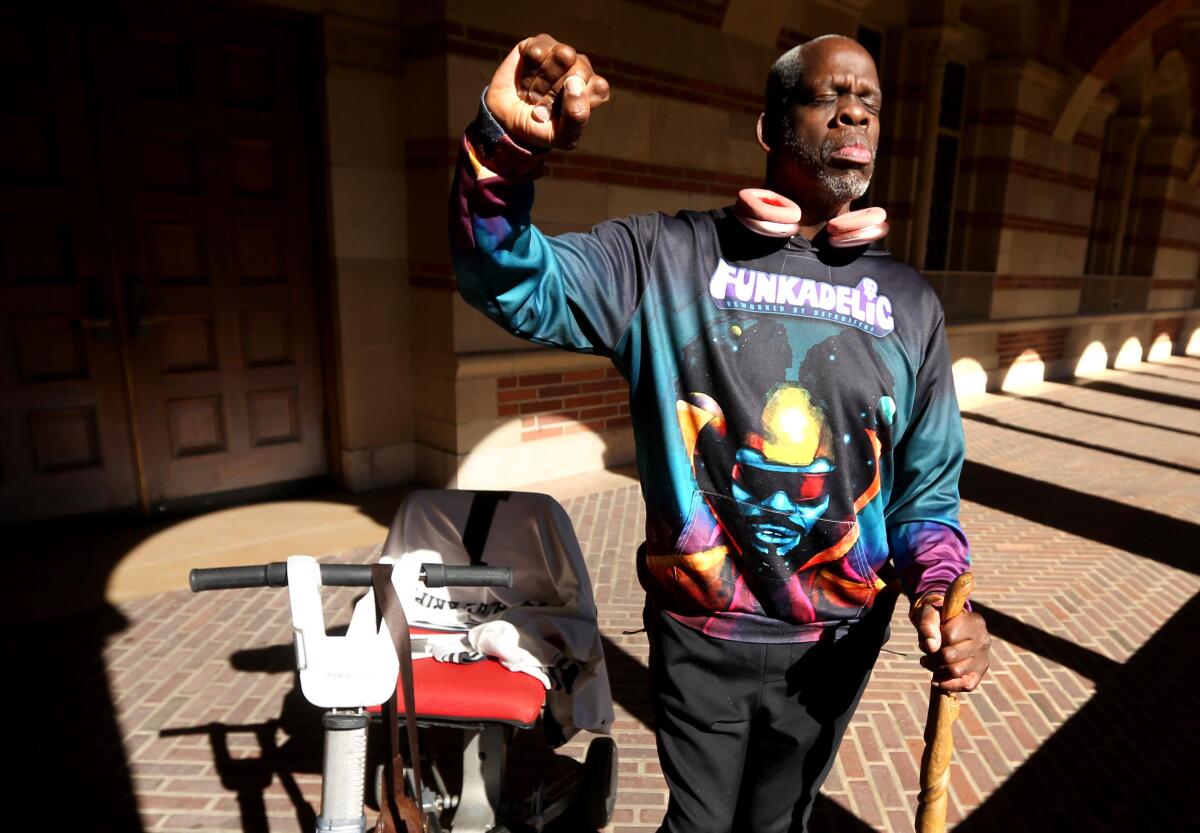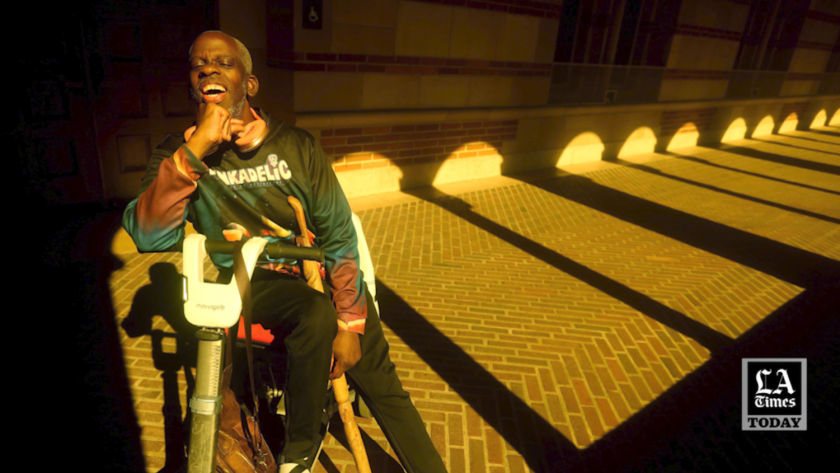UCLA has a new disability studies major — the first of its kind at any public university in California

- Share via
UCLA junior Vivek Chotai doesn’t plan to pursue his school’s new disability studies major — the first of its kind at any public university in the state — or even take classes in it.
Yet for the 21-year-old leukemia survivor and thousands of other disabled students across the University of California and California State University systems, the program is a critical victory in a decades-long battle for visibility and recognition.
“We’re judged by our medical histories,” Chotai said. “[We’re] told that we won’t graduate, that we won’t be healthy, that we are not able to live the lives we want to. Any effort that advances the understanding of our community ... is education that can be used to create change.”
California’s state universities nurtured many of the early leaders of the disability rights movement, whose work on Section 504 of the Rehabilitation Act of 1973 and the Individuals with Disabilities in Education Act opened public schools to millions of disabled children.
UC Berkeley and San Francisco State went on to become early incubators of disability studies, a field of scholarship dedicated to the culture, history and political movements of disabled people. But neither institution offers a full-fledged major in the discipline.
Public universities in Illinois, Wisconsin and Ohio have created successful disability studies programs. Yet California universities — among the best and most elite in the discipline — have struggled to institutionalize disability scholarship and to hire disabled faculty to teach it.
That UCLA now has a disability studies major, announced this month, is a sign that “the stigma around disability is shifting,” said Victoria Marks, a professor of choreography and chair of the UCLA program. “More and more of our communities are speaking up.”
This fall, San Francisco State became just the second CSU school to inaugurate a disability studies minor. The first was Cal State Northridge last spring. UC schools have fared better, starting with the first disability studies minor in the system at Berkeley in 2003.
“My entire time at S.F. State we’ve been trying to get a disability studies minor,” said Emily Smith Beitiks, interim director of the Paul K. Longmore Institute on Disability, whose founder was one of the earliest scholars in the field. “That we had eugenics courses on the books but we’re fighting to get disability studies on the books is painful.”
These days, the discipline is booming. Annual submissions to Disability Studies Quarterly have more than doubled in recent years, and the number of majors and minors in the subject has soared, said Jeffrey A. Brune, co-editor of the journal.
“We see disability as a social construction, very much the same way as race, gender and sexuality are constructed,” he said.
But disability studies programs still face barriers that ethnic and LGBTQ+ studies don’t.
“You’ve got plenty of disabled students, but there’s still very much a pressure to pass as non-disabled — there’s a reluctance even among students who are in wheelchairs,” Brune said. “Now you’re starting to see more students come out and identify as disabled, but not to the extent of students who are queer or who identify with many other groups.”
Instead, many feel pressure to downplay their disability, even as their ethnicity or sexuality may be celebrated, said Quinn O’Connor, one of the student activists behind the push for disability studies at UCLA.
“A lot of people who come to UCLA, they don’t think of disability as one of these identities,” the recent graduate said. “Growing up in an Asian household, I put a lot of pressure on myself to be a great student. I ‘overcame’ [cerebral palsy] — that was the language I grew up with.”

Still, stigma is only part of the problem. Another major barrier is institutional bureaucracy.
For the record:
4:31 p.m. Nov. 28, 2023A previous version of this story misstated the department where CSUN’s disability minor is housed. It is an interdisciplinary minor in the College of Humanities.
Many disability studies programs are housed inside departments of special education. Others end up in rehabilitation or nursing programs, where the “medical model” of disability still often trumps the “critical” perspective most scholars espouse.
“The core of disability studies has been in social sciences and humanities, so it’s a little awkward when it depends on the patronage of professional schools,” Brune said.
Newer programs have found refuge in interdisciplinary studies or in large humanities programs. But these also struggle to hire disabled scholars, who risk losing public health insurance or funding for home care over jobs that are often low-paid and ineligible for tenure.
“They often couldn’t make a lot of money, and they didn’t have the conventional credentials that a department at UC would permanently hire,” said Susan Schweik, professor emeritus and a founder of Berkeley’s program. “UCLA is going to lead the way as a department where disabled faculty are hired in with tenure.”
Many see the current surge in interest in disability studies as part of a sea change sweeping their discipline, and the student populations they serve.
Disability studies came of age alongside the last large generation of polio survivors. Early scholars often lived with highly visible physical or sensory conditions, such as dwarfism, blindness and cerebral palsy.
Today, childhood polio has been all but eradicated. Rates of congenital disabilities such as cerebral palsy, spina bifida and Down syndrome have been falling for decades, as have rates of disabling childhood injuries.
At the same time, advances in treatments for chronic illnesses such as juvenile arthritis mean they no longer create the kind of impairments they once did, while the widespread adoption of cochlear implants has radically altered the experience of deafness.
The number of students who look disabled has plummeted, yet the number of disabled students enrolling in universities has soared.
“We saw a 40% increase in students registering with our disability office” since the pandemic, said Beitiks of San Francisco State.
The number of students receiving disability accommodations across the 10 UC campuses jumped from 5% in 2018 to 7% in 2021.
That’s due in part to the growing rates of autism and attention deficit hyperactivity disorder in young people. But it also reflects the different legal landscape for disability rights in universities.
Disabled primary and secondary students are mainly covered by the Individuals with Disabilities in Education Act, a law narrow enough that even some wheelchair users do not qualify for its protections. That law doesn’t apply to universities.
Accommodations in college and beyond come mainly from Section 504, which covers conditions as varied as anxiety and ulcerative colitis, ADHD and asthma, quadriplegia and cancer. (Section 504 can also be applied in primary schools, but just 85,000 California students use it, compared with 800,000 who are covered by IDEA.)
As more students qualify for disability accommodations, and feel empowered to take them, long-stigmatized diagnoses have transformed into points of identification and affinity.
For Chotai, that meant comparing central line scars with the girl next to him at the Disabled Student Union meeting during freshman year. Central lines are tubes placed in large veins, generally to give fluids, blood or medications.
“Something as simple as bonding over that shared scar made me feel more proud of that memory, instead of shameful,” he said.
But not everyone is so sanguine about the shift.
“I’m glad UCLA has a disability studies program, but what does that do for the community?” asked Leroy Moore, a writer, activist and founder of Krip-Hop Nation, an association of artists with disabilities. Moore, 56, is finishing his PhD in anthropology at UCLA. “The Individuals with Disabilities in Education Act was passed in 1975, and it hasn’t been fully funded since.”
Almost 50 years later, most disabled students still don’t go to college.
“I’m a graduate student talking about the same issues I talked about when I was a teenager,” Moore said. “We all see education as a key to success, but if our laws are not fully funded and not enforced, we don’t have no key.”
- Share via
Watch L.A. Times Today at 7 p.m. on Spectrum News 1 on Channel 1 or live stream on the Spectrum News App. Palos Verdes Peninsula and Orange County viewers can watch on Cox Systems on channel 99.
More to Read
Sign up for Essential California
The most important California stories and recommendations in your inbox every morning.
You may occasionally receive promotional content from the Los Angeles Times.












